|
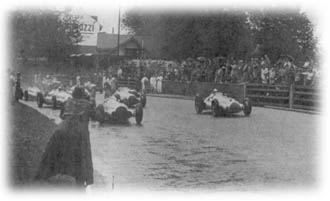 With three races to go, the Formula One circus arrives at the Nurburgring this weekend. Although the track has been changed, shortened and has lost most of its characteristics, the name Nurburgring brings back memories of heroic acts and terrible accidents. A legend of its own, the track has been butchered after Niki Lauda's 1976 accident, to become a faceless track, which hosted the German, European and Luxembourg Grands Prix over the past fifteen years. With three races to go, the Formula One circus arrives at the Nurburgring this weekend. Although the track has been changed, shortened and has lost most of its characteristics, the name Nurburgring brings back memories of heroic acts and terrible accidents. A legend of its own, the track has been butchered after Niki Lauda's 1976 accident, to become a faceless track, which hosted the German, European and Luxembourg Grands Prix over the past fifteen years.
The building of the original Nurburgring was started in 1925 as means of decreasing unemployment in Germany. In 1927 the track was opened, consisting of the 22.8 kilometre Nordschleife and the 7.7 kilometre Sudschleife. The first race was won by Otto Merz in a Mercedes sportscar. In the following years, the race at the Nurburgring was won by legends such as Rudolf Caracciola and Louis Chiron.
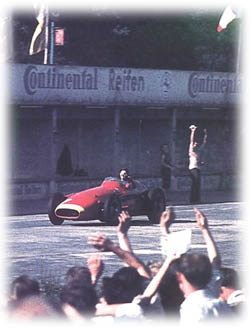 Once the German Grand Prix became part of the Formula One World Championship in 1951, it soon appeared that it was the race where only the very best could win. Alberto Ascari (twice), Giuseppe Farina and Juan Manual Fangio (three times) shared the first six race-wins between them. Once the German Grand Prix became part of the Formula One World Championship in 1951, it soon appeared that it was the race where only the very best could win. Alberto Ascari (twice), Giuseppe Farina and Juan Manual Fangio (three times) shared the first six race-wins between them.
Especially Fangio's third victory stands out as one of the best Formula One races of all times. After a poor start, Fangio's Maserati dropped behind the Ferraris of Mike Hawthorne and Peter Collins. Soon Fangio grabbed back the lead, but with a pitstop for fuel and fresh tyres in mind, he had to push hard to increase the gap to the Ferraris, who were on full tanks with no plans for pitstops. When Fangio pulled in for his stop, he was 28 seconds in front of the competition. Much to Fangio's grief, the stop was executed as bad as humanly possible, leaving the Argentinean over a minute behind his rivals.
Once Fangio got underway again, the crowd couldn't believe their eyes. The Maserati driver was running nine seconds a lap faster than the Ferraris, even breaking the pole-time after eighteen laps. The gap was closing fast and the Ferraris of Hawthorne and Collins were pushing hard to keep their lead, but to no avail. Fangio was driving the race of his life and ran faster and faster, eventually setting the lap record of 9 minutes and 17 seconds, 24 seconds off the standing record.
 On lap 21 of 22, Fangio won his battle and passed Hawthorne for the lead in the Sudcurve, after which the Argentinean took it easy, finishing three seconds ahead of Mike Hawthorne. Fangio later explained that he had never driven like that and never again would. He proved himself right, for it was his final victory. On lap 21 of 22, Fangio won his battle and passed Hawthorne for the lead in the Sudcurve, after which the Argentinean took it easy, finishing three seconds ahead of Mike Hawthorne. Fangio later explained that he had never driven like that and never again would. He proved himself right, for it was his final victory.
Of course the other milestone in the history of the Nurburgring is Niki Lauda's accident in the 1976 race. On lap two of the race Lauda lost control of his Ferrari and crashed across the track into the barriers. The car immediately caught fire and after that was hit by one of the following cars. Lauda was pulled from the wreck by Arturo Merzario, Guy Edwards, Harald Ertl and Brett Lunger, who had all stopped their cars to rescue the unfortunate Austrian.
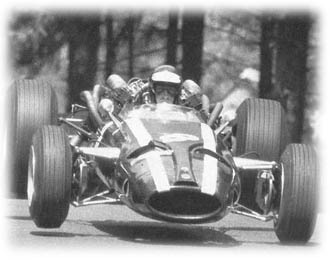 The situation didn't look good for Lauda. He had lost his helmet during the crash, exposing his head to the flames. He was taken to a nearby hospital with severe burns to his head, face and hands, and damaged lungs because of inhaling poisonous gases. Many feared for his life, but after an amazing recovery, Lauda stepped into his Ferrari again just a few weeks after his accident and finished fourth at Monza. Eventually, Lauda's accident did not only cost the Austrian the World Championship, but it also cost the Nurburgring its Grand Prix hosting. The situation didn't look good for Lauda. He had lost his helmet during the crash, exposing his head to the flames. He was taken to a nearby hospital with severe burns to his head, face and hands, and damaged lungs because of inhaling poisonous gases. Many feared for his life, but after an amazing recovery, Lauda stepped into his Ferrari again just a few weeks after his accident and finished fourth at Monza. Eventually, Lauda's accident did not only cost the Austrian the World Championship, but it also cost the Nurburgring its Grand Prix hosting.
Eight years later, the Ring was back on the Formula One calendar as the European Grand Prix, but sadly it had lost almost all of its glory. Of the racers who competed in the final race on the old track, only two were present on the new track: Niki Lauda and Jacques Lafitte, with the former being the centre of attention, returning to the place of his worst nightmare. Lauda was closing in on his third world title with only McLaren teammate Alain Prost left to battle him. The first qualifying session put the Austrian back in fifteenth position after having technical problems. On Saturday the rain made further improvements impossible.
 When the race started, the one thing the organisers prayed for not to happen, did happen: at the first corner, a massive pile-up took place, leaving Ayrton Senna, Gerhard Berger, Keke Rosberg, Marc Surer and Piercarlo Ghinzani beside the track. The race continued without them as a boring procession in which Prost took the victory and Lauda finished fourth, not enough to secure the title. When the race started, the one thing the organisers prayed for not to happen, did happen: at the first corner, a massive pile-up took place, leaving Ayrton Senna, Gerhard Berger, Keke Rosberg, Marc Surer and Piercarlo Ghinzani beside the track. The race continued without them as a boring procession in which Prost took the victory and Lauda finished fourth, not enough to secure the title.
Since the introduction of the new Nurburgring, the exciting moments were few and far between. In the last four years, the Nurburgring has been a part of the Formula One World Championship with Michael Schumacher, Jacques Villeneuve (twice) and Mika Hakkinen taking victories for Ferrari, Williams and McLaren respectively.
Of these four races, last year's one race stands out. With the Ferraris of Michael Schumacher and Eddie Irvine taking up the front row, things didn't look good for Mika Hakkinen and McLaren. 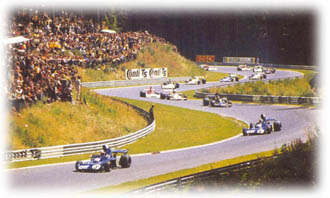 Going into the race, Hakkinen and Schumacher were tied at 80 points in the World Championship standings and with one race to go after the Luxembourg Grand Prix at the Nurburgring, every advantage was more than welcome. Going into the race, Hakkinen and Schumacher were tied at 80 points in the World Championship standings and with one race to go after the Luxembourg Grand Prix at the Nurburgring, every advantage was more than welcome.
The start of the race presented the expected scenario: Schumacher took the lead and Irvine played roadblock to the McLarens. However, Schumacher wasn't able to strike the gap he wanted, only leading by four seconds after ten laps. After that, the German got into the rhythm, gaining a second per lap until Mika Hakkinen passed Irvine. Until the first pitstops, the situation remained unchanged, Hakkinen getting back to five seconds behind Schumacher.
When the smoke of the pitstop had settled down, Hakkinen's McLaren was in the lead to the surprise of many people. After that, Hakkinen was in control, although still driving full force to keep ahead. With a two second lead, Hakkinen crossed the finish-line, taking a four point lead before the final race of the season.
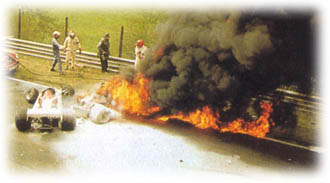
European Grand Prix - Just the Facts
The first European Grand Prix was held at Monza in 1923. It was called the European Grand Prix in order to differ from the only other Grand Prix at that time, run by the Automobile Club de France (ACF), who had held all the Grands Prix up to that time. Monza held a total of three European Grands Prix before the war, Spa held two, and there was one each at San Sebastian (very hot) and Lyons.
After the war, there were European Grands Prix at Spa, Bern and Monza before the initiation of the World Championship as we know it today. The first round of that series was held at Silverstone, the British Grand Prix, but because it was the first round of the championship, it was also afforded the honour of being the European Grand Prix. From 1950 through to 1977 (not including 1953 and 1969-1971) the European Grand Prix title wandered from Grand Prix to Grand Prix around Europe, often coinciding with some special anniversary or suchlike.
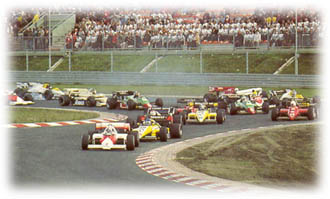 It reappeared at Brands Hatch in 1983 but by now a convenience title for a race held in a country which already had one Grand Prix. So in 1983, the British Grand Prix was at Silverstone, and the European at Brands Hatch, won by Nelson Piquet.
The next year, it was at Nurburgring to mark the opening of the new circuit, and Alain Prost won from flag to flag although it was also noted for a seven car accident. In 1985, it was back at Brands Hatch again - the British Grand Prix had been held there in the intervening year - where Nigel Mansell scored his first ever World Championship win, and Alain Prost clinched his first World Championship title.
The title then became dormant until Tom Wheatcroft persuaded Bernie Ecclestone that a European Grand Prix should be held at Donington in 1993. The Williamses of Alain Prost and Damon Hill filled the first of three European Grand Prix front rows but it was Ayrton Senna who stole the limelight on a damp, murky day. He slipped back to fifth at the start, and then sensationally overtook Michael Schumacher, then Karl Wendlinger, Damon Hill and then Alain Prost to lead at the end of lap one. Making only (!) five pit visits to Hill's six and Prost's seven, the Brazilian won brilliantly in the changing conditions by nearly a lap.
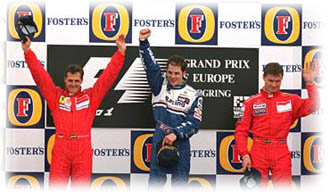 A year later, the Spanish Grand Prix was at the Circuit de Catalunya so the European Grand Prix was held at Jerez, near Seville, former venue for the Spanish Grand Prix itself. This time Michael Schumacher won from pole position with flying lap, and he won again the following year when the European race returned to the Nurburgring for its second visit to the new circuit. The third visit, a year later, was won by Jacques Villeneuve who scored his first victory with a flag-to-flag win by beating Schumacher, now in a Ferrari.
In 1997, Schumacher and Villeneuve were battling again, this time for the championship. The final round of the series was at Jerez which again had the title of European Grand Prix. Of course, everyone remembers Villeneuve coming up on the inside of Schumacher as they braked for the hairpin, the Ferrari driver closing the door too late, colliding, and handing victory in the championship to the Canadian. The race, however, was still not won; the McLarens closed on Villeneuve who obligingly let them both through, and then David Coulthard let Mika Hakkinen through to score his first win of a McLaren one-two. He's scarcely looked back since.
 Last year, the title of European Grand Prix was again unemployed but there have been two more Grands Prix at the Nurburgring, these being Luxembourg Grands Prix. The first was won by Jacques Villeneuve scoring his second win at the circuit - and his most recent - and the second by Mika Hakkinen, he and teammate Coulthard sandwiching Michael Schumacher's Ferrari - the Ferraris had started on the front row.
Now, however, the European Grand Prix returns to the famous Nurburgring, a circuit it first visited no less than 45 years ago. And it's worth noting that the race has only ever been won by World Champions.
|


 Once the German Grand Prix became part of the Formula One World Championship in 1951, it soon appeared that it was the race where only the very best could win. Alberto Ascari (twice), Giuseppe Farina and Juan Manual Fangio (three times) shared the first six race-wins between them.
Once the German Grand Prix became part of the Formula One World Championship in 1951, it soon appeared that it was the race where only the very best could win. Alberto Ascari (twice), Giuseppe Farina and Juan Manual Fangio (three times) shared the first six race-wins between them.







